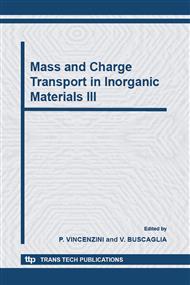p.54
p.63
p.73
p.79
p.89
p.93
p.98
p.104
p.111
Ionic Conductivity of Hydrous Silicate Glasses
Abstract:
Hydrous silicate glasses with different compositions (LiAlSi4O10, CaMgSi2O6, CaMgSi2O6 - CaAl2Si2O8 and (Ca,Ba,Sr)O – SiO2) containing up to 3 wt% H2O were synthesized in platinum capsules at high temperature and pressures from 100 to 500 MPa in an internally heated gas pressure vessel. The water content of the glasses was analyzed by Karl-Fischer titration. Using infrared microspectroscopy the homogeneity of water distribution in the samples was checked and concentrations of OH- groups and H2O molecules were estimated. Frequency-dependent ionic conductivity of the glasses was investigated using impedance spectroscopy. It is shown that the proton conductivity is usually orders of magnitude lower than the partial conductivity of alkalis in silicate glasses. Proton conductivity in hydrous barium silicate glass was found to be more than one order of magnitude higher than in an aluminosilicate glass, supporting that the concentration of non-bridging oxygen is crucial for proton conduction in glasses.
Info:
Periodical:
Pages:
89-92
Citation:
Online since:
October 2006
Authors:
Price:
Сopyright:
© 2006 Trans Tech Publications Ltd. All Rights Reserved
Share:
Citation:


